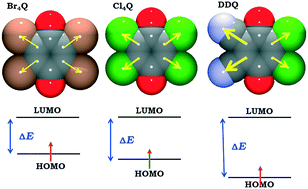当前位置:
X-MOL 学术
›
CrystEngComm
›
论文详情
Our official English website, www.x-mol.net, welcomes your feedback! (Note: you will need to create a separate account there.)
Probing semiconductivity in crystals of stable semiquinone radicals: organic salts of 5,6-dichloro-2,3-dicyanosemiquinone (DDQ) radical anions†
CrystEngComm ( IF 3.1 ) Pub Date : 2018-02-14 00:00:00 , DOI: 10.1039/c7ce02146a Krešimir Molčanov 1, 2, 3 , Dietmar Stalke 4, 5, 6, 7 , Ana Šantić 1, 2, 3 , Serhiy Demeshko 4, 5, 6, 7 , Vladimir Stilinović 2, 3, 8, 9, 10 , Zhongyu Mou 11, 12, 13 , Miklos Kertesz 11, 12, 13 , Biserka Kojić-Prodić 1, 2, 3
CrystEngComm ( IF 3.1 ) Pub Date : 2018-02-14 00:00:00 , DOI: 10.1039/c7ce02146a Krešimir Molčanov 1, 2, 3 , Dietmar Stalke 4, 5, 6, 7 , Ana Šantić 1, 2, 3 , Serhiy Demeshko 4, 5, 6, 7 , Vladimir Stilinović 2, 3, 8, 9, 10 , Zhongyu Mou 11, 12, 13 , Miklos Kertesz 11, 12, 13 , Biserka Kojić-Prodić 1, 2, 3
Affiliation

|
The structural parameters and semiconductivity of crystals with stacked 5,6-dichloro-2,3-dicyanosemiquinone (DDQ) radicals were studied for a series of the first nine salts of DDQ with substituted N-ethyl- and N-methylpyridinium cations. Structures with stacks of equidistant radicals (interplanar separation <3.3 Å) are fairly good semiconductors (10−9 S cm−1), while those with Peierls-distorted stacks comprising diamagnetic dimers of radicals (interplanar separations are <3.1 Å within the dimers and >3.4 Å between the dimers) are insulators. DFT calculations indicate the covalent character (pancake bonding) of the interactions between the DDQ radical anions. The inductive effects of electronegative substituents (halogeno and cyano) on the quinoid ring stabilise the radicals, but also increase the HOMO–LUMO gap, resulting in lower electrical conductivity.
中文翻译:

探测稳定的半醌自由基晶体中的半导电性:5,6-二氯-2,3-二氰基氨基醌(DDQ)自由基阴离子的有机盐†
研究了带有堆叠的5,6-二氯-2,3-二氰基米醌(DDQ)自由基的晶体的结构参数和半导电性,该序列涉及DDQ的前九个盐系列,这些盐带有取代的N-乙基和N-甲基吡啶鎓阳离子。具有等距自由基堆叠的结构(面间距<3.3Å)是相当好的半导体(10 -9 S cm -1),而带有Peierls扭曲堆叠且包含自由基的反磁性二聚体(平面内间隔在二聚体内<3.1Å而在二聚体之间> 3.4Å)的那些则是绝缘体。DFT计算表明DDQ自由基阴离子之间相互作用的共价特征(薄饼键合)。喹啉环上带负电的取代基(卤素和氰基)的感应作用使自由基稳定,但同时又增加了HOMO-LUMO间隙,从而降低了电导率。
更新日期:2018-02-14
中文翻译:

探测稳定的半醌自由基晶体中的半导电性:5,6-二氯-2,3-二氰基氨基醌(DDQ)自由基阴离子的有机盐†
研究了带有堆叠的5,6-二氯-2,3-二氰基米醌(DDQ)自由基的晶体的结构参数和半导电性,该序列涉及DDQ的前九个盐系列,这些盐带有取代的N-乙基和N-甲基吡啶鎓阳离子。具有等距自由基堆叠的结构(面间距<3.3Å)是相当好的半导体(10 -9 S cm -1),而带有Peierls扭曲堆叠且包含自由基的反磁性二聚体(平面内间隔在二聚体内<3.1Å而在二聚体之间> 3.4Å)的那些则是绝缘体。DFT计算表明DDQ自由基阴离子之间相互作用的共价特征(薄饼键合)。喹啉环上带负电的取代基(卤素和氰基)的感应作用使自由基稳定,但同时又增加了HOMO-LUMO间隙,从而降低了电导率。



























 京公网安备 11010802027423号
京公网安备 11010802027423号